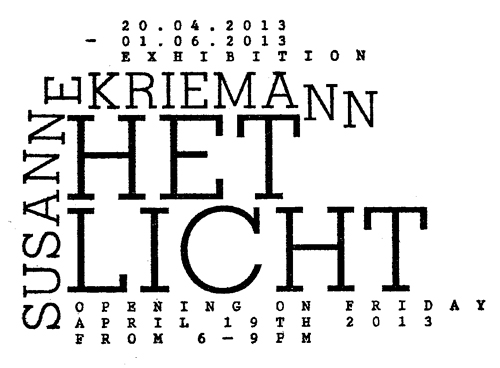PRESS RELEASE
Susanne Kriemann. Het Licht
April 20 – June 1, 2013
Pfingstweidstrasse 23 / Welti-Furrer Areal, 8005 Zürich
Opening reception: Friday April 19, 6 – 9 pm
RaebervonStenglin is delighted to present Susanne Kriemann's second solo exhibition with the gallery. Het Licht deals with the disappearance of a specific site: the Art Deco building 'Het Licht' (The Light), a former newspaper printing workshop in Ghent. Photographing the building in a state of abandoned decay a month before its demolition, Kriemann allows her subject's physical dissolution to reverberate through an 'aesthetics of ephemerality', capturing 'The Light' through the light of past moments.
Kriemanns' projects proceed through intense research and sensitivity to history, finding paradigmatic significance within the particular. Her art uses photography's self-reflexivity to explore change and obsolescence, probing the ideological and human significance embedded in physical structures. Het Licht was an iconic landmark dating from 1930–31, designed by the architect Ferdinand Brunfaut as a print workshop. It served its original purpose for the newspaper 'Vooruit', and later De Morgan, until its closure in 1981 left it derelict. In 1990, following its recognition as an officially protected monument, the building became home to the cultural centre Backstage but was forced to close again after being deemed a fire hazard. After years of squatting and abandonment, the interior of the building was destroyed to make way for student flats last year, leaving only the original facade remaining.
Kriemann documented Het Licht in natural light, using both digital and analogue photography and then radically manipulating the resulting images. “For Het Licht ” she explained, “I will scan, retouch, rework, solarise, boil, dry, water and reprint the documents and present them in different formats like a newspaper or in light boxes in
order to allow the viewer to stroll once more (virtually) through the rooms, which are demolished as we act.” Her actions parallel the treatment of the building, mirroring its many styles and corroded, graffitied surfaces; whilst the ephemerality of analogue photographs and the immateriality of digital images together suggest the vulnerability of history and the past's propensity to be continuously re-written. Presenting 'Het Licht' as images on tables dramatically lit within the darkened gallery and accompanied by newspapers whose print is blackened by bright light, Kriemann adds another layer to the history of the building, all the while stressing its ultimate disappearance.



































